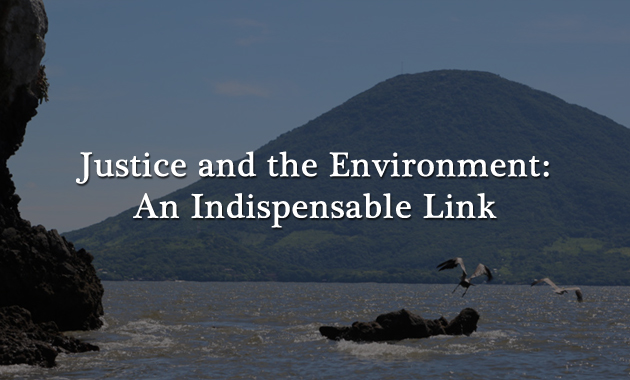- English
- Español
Media Center
Feature

The judiciary plays a key role in efficiently protecting the right to a healthy environment
A new OAS initiative empowers judges of the Hemisphere to make decisions that have a positive impact on the environment
Secretary General Almagro: “More rights for more people includes the right to a healthy environment”
February 12, 2016
It took the population of the Matanza-Riachuelo region, in Argentina, over 200 years to have its right to live in a healthy and clean environment validated. Slaughterhouses, salteries, refrigerated warehouses, tanneries, and petrochemical plants located nearby caused the pollution to rise making it practically impossible to breathe on its banks, which lacked sewage and waste collection systems.
In the mid-1800s, health authorities had already noted that there was no organic life in the Riachuelo’s waters, which gave an indication on the high levels of pollution at that time. In 2004, the river basin’s issue was brought to the courts on the initiative of a small group of La Villa’s residents who filed a lawsuit demanding environmental sanitation.
In July 2008, the National Supreme Court of Justice issued a ruling that condemned for damages and prejudices the national State, the province, the city of Buenos Aires, as well as 44 surrounding businesses for dumpling directly into the river their hazardous waste.

The right to live in a clean environment is an integral part of the agenda “more rights for more people” that the OAS promotes.
This ruling, known as the “Fallo Mendoza” and considered a landmark for enforcing environmental rights, has positioned Argentina as the leader in the Hemisphere on that issue. It requires the authorities to control industrial pollution, clean up landfills, relocate residents, expand water systems, as well as implement a sanitary plan, which has changed the quality of life of the people living in that area in order to provide them with adequate sanitation and a clean environment. None of this would have been possible without an environmental conscience and without legislation on environmental protection. It wouldn’t have been possible either without the commitment of judges to apply the law.
Caring for our Common Home from the Judiciary
With the purpose of strengthening and promoting the role of the judiciary in environmental protection, the Organization is launching the initiative, “Caring for our Common Home from the Judiciary: Guaranteeing More Rights for More People in the Americas,” in order to make further progress in the effective realization of the right to a healthy environment and other fundamental rights. The project assumes that protecting planet Earth is providing “More rights for more people,” and that it is the common responsibility of lawmakers, judges, lawyers, attorneys general and, ultimately, the people.
The initiative is made up of five elements:
- Implementation of the Inter-American Program on Judicial Training on Environmental Law
- The Judiciary as Goodwill Ambassador for Environmental Justice
- Development of a Model Performance Protocol for the Judiciary in environmental matters and rights to access
- Participation of the Judiciary in Mother Earth International Day and the Inter-American Congress on the environmental rule of law
- Launching of the Portal on the environmental rule of law in the Americas.
Each element of the initiative seeks to create an ecological citizenship and a paradigm shift to ensure that justice and the rule of law can work in an ethic that favors the most vulnerable in the Americas. OAS Secretary General Luis Almagro recalled that “‘more rights for more people’ includes the right to a clean environment.”
“More Rights for More people”
The right to live in a clean environment is an integral part of the agenda “more rights for more people” that the OAS promotes. The role of the courts in that process is becoming more relevant, and although 24 OAS member states have recognized the right to a healthy and balanced environment as a fundamental right, the Organization has placed implementing and expanding that right on the central part of its sustainable development agenda.
As in Argentina, there have been other important examples in the region on how to achieve the protection of collective rights through a court sentence, such as the cases of the STJ in Brazil with the implementation of the in dubio pro natura and non-regression principles; Chile with its innovative decisions implementing the precautionary principle and repairing damage by replacing nature for nature; and Mexico with the Tulum case protecting cultural environmental heritage.
More than a common cause
In his recent encyclical, Pope Francis urged to “hear both the cry of the earth and the cry of the poor.” Environmental law thus becomes something transcendental in the present, but is also a right linked to future generations who can benefit from natural resources in a sustainable manner. The OAS has contributed to the debate not only with the exchange of ideas, but also as the manager and promoter of change.
The programs of the Organization aim at fostering appropriate and applicable law, access to justice and information, public participation, equity and inclusion, accountability, transparency, responsibility for environmental damage, implementation, and human rights.
Last year, the OAS, in collaboration with other organizations and the Government of Jamaica, organized the First Inter-American Congress on the Environmental Rule of Law in Montego Bay, Jamaica, which concluded with a call to strengthen the rule of law to address environmental challenges in the Americas.
As part of the debate, the OAS has assisted countries in identifying the legal framework for the management of water resources, developing guidelines for the ties between trade, investment and the environment, advancing in the prevention and management of conflicts related to shared natural resources, and to achieving an effective implementation and enforcement of environmental law.
Reference: E-015/16


